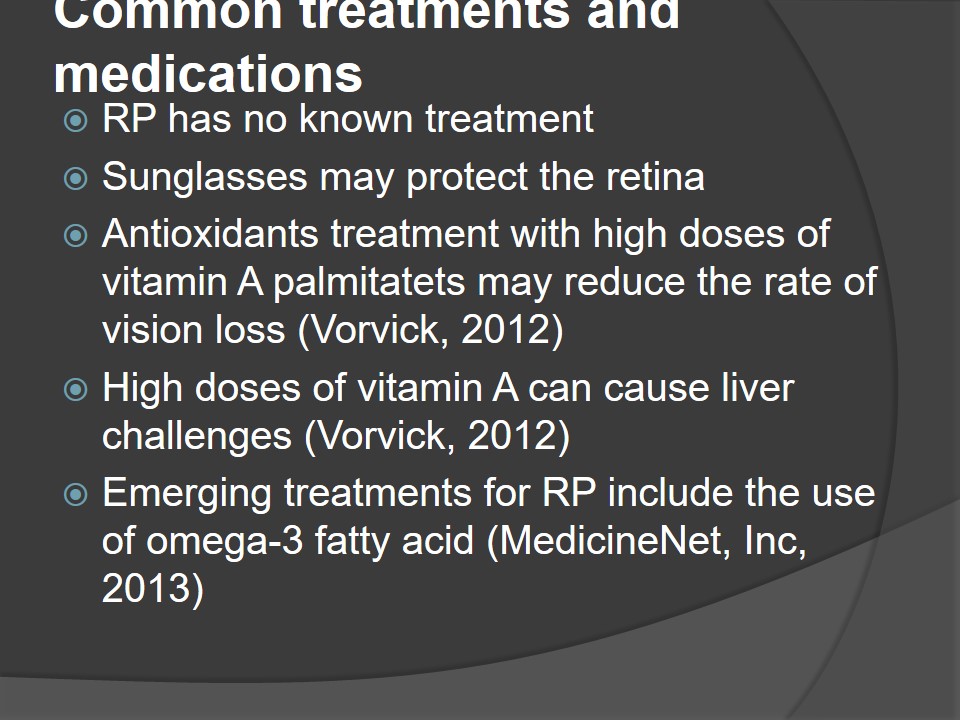Description of Retinitis Pigmentosa
- RP is hereditary eye disease.
- RP is progressive and degenerative.
- It causes severe vision impairment.
- RP normally leads to blindness.

The parts of the visual system affected
- RP affects the retina.
- Retina is a layer of light-sensitive tissue behind the eye.
- RP impairs light-sensing cells, which result in vision loss.
- It affects rods and cones.


Causes of RP
- The condition is hereditary (Hamel, 2006).
- It starts with one eye and later affects the other one with time.
- Many cases of RP involve same family members.
- Inheritance of RP can occur through genes (both recessive and dominant genes) or sex-linked genes (Daiger, Bowne and Sullivan, 2007).
- There are few cases with no family history.
- Diagnosis may occur in teenage years, but the condition may be present at birth.

Symptoms and signs of RP
- Increasing difficulty in night vision.
- Decreased vision in low lights.
- Difficulties in peripheral vision (side vision).
- Peripheral vision leads to tunnel vision.
- Tunnel vision results from a loss of visual acuity in the fields of peripheral visual, but retains visual acuity at the center.
- Night blindness develops before tunnel vision (the difference may be several years or decades) (Koenekoop, 2003).
- A loss of central acuity occurs in later stages (Vorvick, 2012; Hartong, Berson and Dryja, 2006).

Signs and tests
- Color vision (Sieving and Caruso, 2008).
- Pupil reflex response.
- Ophthalmoscopy examination of the retina with dilated pupils.
- Visual acuity.
- Visual field test or Side vision test.
- Retinal photography.
- Slit lamp test.
- Refraction test (Vorvick, 2012).

Effects RP on the visual system
- RP affects peripheral and central acuity leading to loss of vision (Berson, 2007).
- Patients show cataracts and swollen retina at early ages.
- Cataracts are removable.
- Other conditions may exhibit similar symptoms like RP:
- Friedreich’s ataxia;
- Usher syndrome;
- Laurence-Moon syndrome;
- Myotonic dystrophy.

Common treatments and medications
- RP has no known treatment.
- Sunglasses may protect the retina.
- Antioxidants treatment with high doses of vitamin A palmitatets may reduce the rate of vision loss (Vorvick, 2012).
- High doses of vitamin A can cause liver challenges (Vorvick, 2012).
- Emerging treatments for RP include the use of omega-3 fatty acid (MedicineNet, Inc, 2013).
- Scientists have invented microchip implants for RP. They act like microscopic video camera inside the retina.
- This technology is in early stages of development.
- Complete blindness may be rare.
- RP normally progress but at a slow pace.
- Regular visits to low-vision specialists are necessary for vision loss adaptation.


Prevention of RP
- Genetic testing may predict risks of RP in children.
- Genetic counseling may help in determining whether children will suffer RP.
- It is important to visit health care facilities when one experiences night vision loss or when other symptoms emerge.

Summary
- RP lasts for a lifetime.
- Blindness progresses with age.
- RP prognosis is poor due to lack of treatment.
- Cataracts are common in patients with RP.
- Cataract removal through surgery does not enhance retinal function.
- Researchers are work on potential cures.



References
- Berson, L. (2007). Long-term visual prognoses in patients with retinitis pigmentosa: the Ludwig von Sallmann lecture. Exp. Eye Res., 85(1), 7–14.
- Daiger, P., Bowne, J., and Sullivan, L. (2007). Perspective on genes and mutations causing retinitis pigmentosa. Arch Ophthalmol, 125(2), 151-8.
- Hamel, C. (2006). Retinitis pigmentosa. Orphanet J Rare Dis., 1, 40.
- Hartong, T., Berson, L., and Dryja, P. (2006). Retinitis pigmentosa. Lancet 368(9549), 1795–809.
- Koenekoop, R. (2003). Novel RPGR mutations with distinct retinitis pigmentosa phenotypes in French-Canadian families. American Journal of ophthalmology 136(4), 678–68.
- MedicineNet, Inc. (2013). Retinitis Pigmentosa. Web.
- Sieving, P., and Caruso, R. (2008). Retinitis pigmentosa and related disorders. In M. Yanoff and S. Duker (Eds.), Ophthalmology. (3rd ed.) (p. 10). Maryland Heights, Mo: Mosby Elsevier.
- Vorvick, L. (2012). Retinitis pigmentosa. Web.